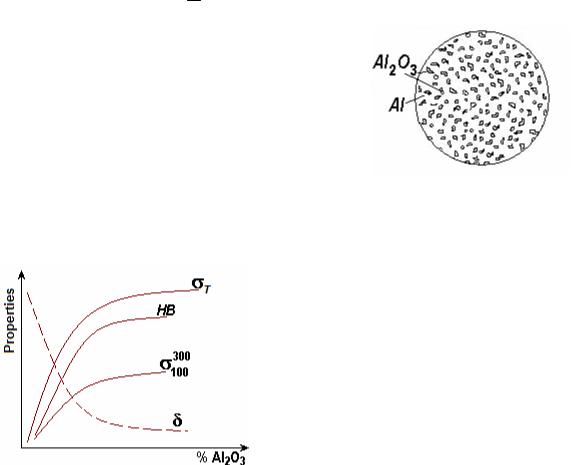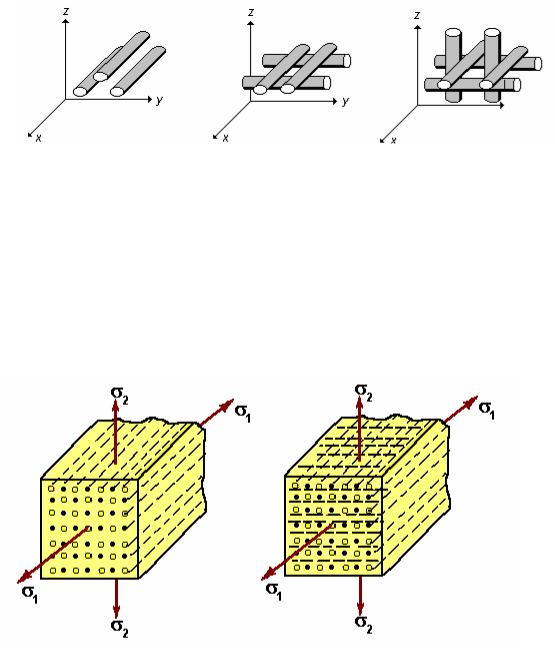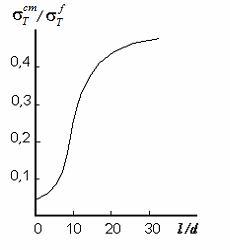
Constr_materials
.pdf
animals are constructed from rigid threads of phosphate salts and soft, viscous protein collagen.
Properties of composite materials depend on properties of components and bond strength between them. Characteristic feature: composites show advantages of components, instead of their lacks. In addition, composites have properties not revealed by any of their component. Therefore composites’ components with properties supplementing each other are chosen.
Structure of composites
The composite material consists of a basis, or a matrix (metal or polymeric) and a filler, or a reinforcing component.
The matrix binds a material in a single whole, forms it. The technology of material manufacture involving working temperature, specific strength σT/γ, and fatigue strength σ-1 depend on the properties of the matrix.
The filler is distributed in a matrix uniformly in a certain order. The filler takes up a load; therefore it should have high strength, hardness and elastic modulus.
The matrix distributes loading between particles of the filler, protects their surface and raises the energy of crack propagation to prevent brittle failure. The matrix is not strengthened; it is the difference of composites from metal alloys.
By their shape, the fillers can be zero-dimensional, one-dimensional and two-dimensional (Fig. 12.10).
The composite materials strengthened by small particles of filler, are called dispersion-hardened materials. The composites containing fibres are named fibrous composites. Two-dimensional fillers are applied, basically, in polymeric composites.
а |
b |
c |
Figure 12.10 Shape of fillers in composites:
а – particles; b – fibres; c – plates, sheets, fabric
Dispersion-hardened composite materials
The fillers are particles of refractory substances: oxides, carbides, nitrides. Usually they are Al2O3, SiO2, BN, SiC.
Materials with low density (aluminum, magnesium, titanium and their alloys), or heat resisting materials (nickel) are applied for matrixes.
131
Created with novaPDF Printer (www.novaPDF.com). Please register to remove this message.

Dispersion-hardened composites are obtained by pressing and sintering or by introduction of filler into a liquid matrix before casting.
In this kind of composites the matrix carries the basic loading, and particles of filler disturb to movement of dislocations. For them the following
relation is valid: Y 1 , where R is a distance between particles of filler.
R

For single-axis reinforcing, the anisotropy appears so that in the direction of fibres strength is higher than in transversal direction (because the load is carried by a fibre, and a matrix is the transmitting medium). For biaxial reinforcing the anisotropy is not present, but strength along an axis of fibres reduces by a factor of 3 approximately (Fig. 12.14).
The thinner and longer is a fibre, the higher is the strengthening degree (see fig. 12.15).
а |
b |
c |
Figure 12.13 Arrangement of reinforcement fibres in composites:
а – single-axis; b – biaxial; c – three-axial
The volume fraction of fibres makes from several percent to 80-90 %. The increase in filler content serves to enhance the strength and other characteristics.
For example, composite consisting of aluminum and boron fibres has tensile strength at a level of 1200 MPa (as carbon steels have), and specific strength much more exceeding that of steels.
σT1 > σT2 |
σT1 = σT2 |
a |
b |
Figure 12.14 Strength at single-axis (а) and biaxial (b) reinforcement
133
Created with novaPDF Printer (www.novaPDF.com). Please register to remove this message.

Fibrous composites are manufactured by forming the fibres in a matrix powder, fibre impregnation by liquid metal of a matrix, matrix deposition onto fibres with the subsequent formation and sintering and by other ways. The method of directed crystallisation of eutectics is more and more applied too.
Problems of composites technology is that fibres of boron, carbon, silicon carbide and others badly stick to the matrix and are not wetted by liquid matrix metal. Good adhesion is provided by diffusion processes and chemical reactions (usually intermetallic phases form on a boundary matrixfibre). It is necessary to apply various methods, for example, to put preliminary metal coverings on fibres which improve adhesion, but doing so will increase the costs of material. Sometimes etching the fibre surface helps. It improves bonding with matrix metal. On the surface of boron or carbon fibres single crystals of silicon carbide SiC are grown up, and fibres become fleecy. It is possible to grow boron crystals on the surface of thin 12 µm diameter tungsten wire. All fibres will have diameter 70-200 µm. Such fibres are more strongly bonded to a matrix.
The basic disadvantage with the fibrous composites is their high cost and complicated production.
Carbon fibres are slightly cheaper. They are produced from synthetic organic fibres by high-temperature processing. They can be made in the form of yarns, threads, a fabric, tapes. Each fibre consists of the smallest ribbons – fibrillas.
Figure 12.15 Dependence of composite strengthening degree on ratio l/d of filler: l – fibre length; d – fibre diameter
Glass fibres can have square, rectangular, hexagon shape for the best packing in a matrix.
Composites application increases every year. The main consumers are aircraft, rocket and space techniques. Light and strong casings, combustion chambers of rocket engines, blades of turbines and screws, body parts of cars are made of them.
The major part of a turbine is a blade made of a nickel alloy and strengthened by threads of
134
Created with novaPDF Printer (www.novaPDF.com). Please register to remove this message.
sapphire Al2O3, such a component serves to maintain the temperature of input gases as high as 1650 С! The tensile strength of threads is higher than 700 MPa.
Nozzles of rockets are made of tungsten or molybdenum powders with ceramic threads Al2O3 in the shape of fibres or felt to increase their strength by a factor of 2.
Composite materials with polymeric matrix
In composites based on polymers, the load is transferred from a matrix to the reinforcing fibre at the expense of adhesive intermolecular interaction forces. Full wetting of fibres’ surfaces by liquid binding is necessary.
Boron and carbon fibres are better wetted with epoxy resin. Boron and carbon plastics are produced with this matrix.
Glass-fiber plastics have the maximum strength and specific strength as follows: σT is equal to 700 MPa and even 2400 MPa (if reduce fibres diameter and add single crystals of Al2O3 to a matrix).
Composites are joined by spot welding, gluing, using combination of gluing and bolting or riveting.
Questions and problems
1.What groups of non-metallic structural materials are used in machine building?
2.Cite the restrictions in metals and alloys application.
3.Analyze advantages and disadvantages of plastics as a structural material (compare with metallic materials).
4.Compare the structure and properties of thermoplastic and thermosetting polymers.
5.How the crystal structure in polymers is arranged?
6.Describe behaviour of polymers upon loading and heating.
7.Structure, properties and application of ceramics.
8.What is inorganic glass? How to manufacture it? Where is it used?
9.What are crystalline glasses? How to obtain them? Where are they used?
10.Give the definition to composite materials. Describe the characteristic features of composites.
11.What are matrix and reinforcement? What materials are used in the capacity of matrix and reinforcement?
135
Created with novaPDF Printer (www.novaPDF.com). Please register to remove this message.
R E F E R E N C E S
1.Callister, William D. Materials Science and Engineering. – 2000, John Wiley & Sons, New York, USA.
2.Ashby, Michael F. and Jones, David R.H. Engineering Materials 1: An Introduction to Properties, Application and Design. – 2005, Elsevier Butterworth-Heinemann, Oxford, United Kingdom.
3.Ashby, Michael F. and Jones, David R.H. Engineering Materials 2: An Introduction to Microstructures, Processing and Design. – 2006, Elsevier Butterworth-Heinemann, Oxford, United Kingdom.
4.Gregory S. Rohrer. Structure and Bonding in Crystalline Materials. – 2004, Cambridge University Press, United Kingdom.
5.Timings, R.L. General Engineering. – 1995, Longman, Grate Britain.
6.Shigley, J.E., Mischke C.R. Mechanical Engineering Design. – 2001, McGraw-Hill, New York, USA.
7.Егоров Ю.П., Лозинский Ю.М., Роот Р.В., Хворова И.А. Материаловедение: учебное пособие. – Томск: Изд-во ТПУ, 2010.
8.И.А. Хворова. Материаловедение. Технология конструкционных материалов: учебное пособие. − Томск: Изд-во ТПУ, 2011.
9.Лахтин Ю.М., Леонтьева В.П. Материаловедение: учебник для
студентов машиностроительных специальностей ВУЗов. – М.: Машиностроение, 2008.
10.Арзамасов Б.И., Сидорин И.И. и др. Материаловедение: учебник для высших технических учебных заведений. – М.: Машиностроение,
2005.
11.http://techlibrary.ru/
12.http://www.materialscience.ru/subjects/materialovedenie/knigi/
13.http://www.docload.ru/
14.http://nayilz.narod.ru/PorMet/
15.http://www.naukaspb.ru/spravochniki/Demo%20Metall/predisl.htm
136
Created with novaPDF Printer (www.novaPDF.com). Please register to remove this message.

Educational Edition
Национальныйисследовательский Томскийполитехническийуниверситет
ХВОРОВАИринаАлександровна
МАТЕРИАЛОВЕДЕНИЕ
Учебноепособие
ИздательствоТомскогополитехническогоуниверситета, 2012
Наанглийскомязыке
Published in author’s version
Science Editor Doctor of …,
Professor Name
Typesetting Name
Cover design Name
Printed in the TPU Publishing House in full accordance with the quality of the given make up page
Signed for the press 00.00.2012. Format 60х84/16. Paper “Snegurochka”. Print XEROX. Arbitrary printer’s sheet 12.32. Publisher's signature 11.16.
Order XXX. Size of print run XXX.
Tomsk Polytechnic University Quality management system
of Tomsk Polytechnic University was certified by NATIONAL QUALITY ASSURANCE on BS EN ISO 9001:2008
 . 30, Lenina Ave, Tomsk, 634050, Russia
. 30, Lenina Ave, Tomsk, 634050, Russia
Tel/fax: +7 (3822) 56-35-35, www.tpu.ru
137
Created with novaPDF Printer (www.novaPDF.com). Please register to remove this message.
